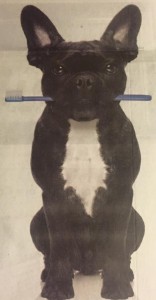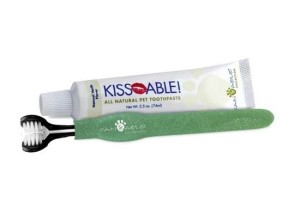 Oral Hygiene is imperative for your dog at any age, not just because of cosmetic reasons or to prevent bad breath, but to improve your dog’s overall health as well as prevent disease.
Oral Hygiene is imperative for your dog at any age, not just because of cosmetic reasons or to prevent bad breath, but to improve your dog’s overall health as well as prevent disease.
Why? First of all, over 80 percent of our canine family members have significant oral pathology.
“The toxins from periodontal disease are absorbed into the dog’s blood stream. As the kidneys, liver, and brain filter the blood, small infections occur causing permanent and at times fatal organ damage. After periodontal disease is treated, and the owners give proper home care, most dogs respond wonderfully due to the decreased pain and infection.” – Diplomate of the American Veterinary Dental College, Jan Bellows DVM, of Hometown Animal Hospital and Dental Clinic in Weston, Florida.
Some dental disorders that can result from poor dental habits are Gingivitis, Periodontitis, Pyorrhea, Caries, Plaque, Calculus, Cavities and more. Some symptoms of a possible issue are of course discolored teeth with excessive plaque, discolored or sore gums, or bad breath.
Prevention is worth a Pound of Cure
The best way to prevent disease is brushing your dog’s teeth everyday, at best, but at least once or twice per week. How do you get a dog trained to endure teeth brushing everyday?
 Get the right supplies. (Don’t use human toothpaste.) Get a vet approved dog toothbrush and a dog toothpaste in a flavor you know your dog will enjoy. They even have brushes that fit on your finger so you have more control over the brushing process, and may be easier to use.
Get the right supplies. (Don’t use human toothpaste.) Get a vet approved dog toothbrush and a dog toothpaste in a flavor you know your dog will enjoy. They even have brushes that fit on your finger so you have more control over the brushing process, and may be easier to use.- Start training your puppy (or dog at any age) with your finger. Put a small amount of dog toothpaste and let your dog lick the paste off your finger, so they get used to the taste as well as your finger/hand near their mouth. Do this for 2-3 days.
- Begin rubbing the paste on their front teeth while holding their gums away from the teeth. If the dog permits this without incident, reward and praise them. Do this for 1-2 days.
 On the fourth or fifth day, introduce the brush with the paste applied to it. Let the dog lick the paste off the brush. After he has successfully licked the paste off, and has gotten used to the brush near his mouth, the texture of the brush and it close to his mouth, reward and praise him.
On the fourth or fifth day, introduce the brush with the paste applied to it. Let the dog lick the paste off the brush. After he has successfully licked the paste off, and has gotten used to the brush near his mouth, the texture of the brush and it close to his mouth, reward and praise him.- If your dog feels comfortable with the brush, you can actually begin brushing his or her teeth. Gently hold the brush to your dog’s mouth at 45 degree angle. Brush the outside of each tooth only by moving the brush back and forth. The dog’s tongue will take care of the inside of the teeth. As you brush, move gently, slowly and soothe your dog with positive praise and consoling voice. Make the first few sessions short, and lengthen the time each session until you work up to a complete and thorough cleaning of their teeth. As you extend your sessions, you can begin brushing their gums and their tongues.
- In between brushes, you can use dental pads, dental dog treats, dental rawhides, or dental dog bones.
If you tend to forget, set a reminder on your phone or put it in your calendar. And remember, oral hygiene is imperative for your dog’s health.
“When a client asks me how long their puppy will live, I usually respond 15-17 years if you brush their teeth daily … 11-13 years if you don’t.” – Dr. Bellows.
For a demonstration of brushing your dog’s tooth:
